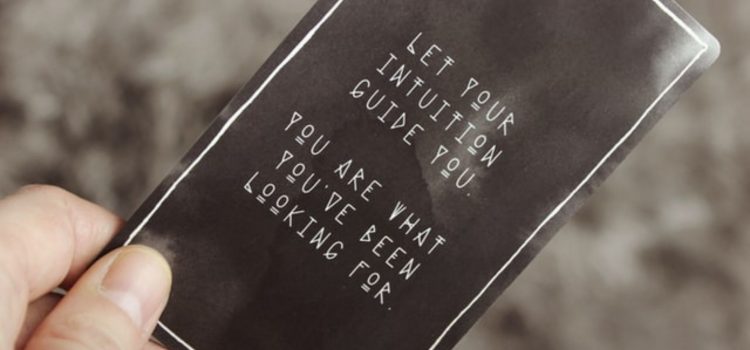

This article gives you a glimpse of what you can learn with Shortform. Shortform has the world’s best guides to 1000+ nonfiction books, plus other resources to help you accelerate your learning.
Want to learn faster and get smarter? Sign up for a free trial here .
Have you ever been in a situation where you intuitively knew the right thing to do but couldn’t explain why or how you arrived at that knowledge? How does intuitive thinking work? Should you always trust your intuition?
When we think unconsciously or intuitively, we make judgments without understanding why, or sometimes even without realizing we’ve made them. However, that does not mean that intuitive thinking is a fluke or some higher power guiding us—there is a logical explanation for it.
Keep reading to learn how intuition works and how you can access it on demand.
How Does Intuition Work?
To understand how intuitive thinking works, you first need to understand that the mind operates on two thinking modes: system 1 and system 2 thinking.
System 1 Thinking: operates automatically and quickly, with little or no effort, and no sense of voluntary control
- Examples: Detect that one object is farther than another; detect sadness in a voice; read words on billboards; understand simple sentences; drive a car on an empty road.
System 2 Thinking: allocates attention to the effortful mental activities that demand it, including complex computations. Often associated with the subjective experience of agency, choice and concentration
- Examples: Focus attention on a particular person in a crowd; exercise faster than is normal for you; monitor your behavior in a social situation; park in a narrow space; multiple 17 x 24.
System 1 was crucial for human evolution. Early human hunter-gatherers who reacted instinctively to the snap of a twig were far more likely to survive than those who took the time to consciously decide whether the sound most likely came from a predator. Relying on system 1 was an adaptive trait: The instinctive reactors were more likely to survive long enough to pass on their genes to the next generation.
We still rely on intuitive system 1 for survival, but the modern world often presents us with problems that system 1 is not equipped to handle. This is where the conscious, thoughtful system 2 comes in.
TITLE: Thinking, Fast and Slow
AUTHOR: Daniel Kahneman
TIME: 66
READS: 53.8
IMG_URL: https://www.shortform.com/blog/wp-content/uploads/2019/11/thinking_cover.jpg
BOOK_SUMMARYURL: thinking-fast-and-slow-summary-daniel-kahneman
AMZN_ID: B00555X8OA
Intuitive thinking is system 1 thinking. It’s fast and it happens without our conscious awareness. When we know “in our bones” that something is true, despite having very little information about the situation at hand, we are using system 1 intuitive thinking.
But where does this information come from? In his book Blink, Malcolm Gladwell explains that when we are using intuitive thinking, we are actually drawing from a vast database of information stored in the unconscious mind. The unconscious mind takes what Gladwell calls a “thin slice”—a very small segment of the experience—and quickly recognizes patterns in it.
Gladwell introduces psychologist John Gottman’s “love lab” as an analogy for what’s happening in our brains when we thin-slice. Since the 1980s, more than 3,000 married couples have taken part in Gottman’s research at the University of Washington. Gottman’s work suggests that if you know how to “thin-slice” a marriage—that is, if you know which information is relevant and which isn’t—you can accurately predict the future of the marriage.
Gottman and his colleagues videotape couples having a “meaningful interaction,” perhaps discussing a point of contention or talking about how they met. They also hook the subjects up to sensors that take physiological measurements.
The way Gottman zeroes in on the most important pieces of information is similar to what our unconscious minds do when they thin-slice. A well-trained unconscious mind lasers in on the most significant details and disregards the rest. This is why thin-slicing allows for speedy intuitive thinking, since it doesn’t involve processing a lot of information.
According to Gladwell, Gottman’s work provides two important takeaways that help us understand how the unconscious mind works when it thin-slices:
#1. The Process of Thin-Slicing Identifies Patterns
There are patterns, or “signatures,” that the conscious mind doesn’t pick up. The unconscious mind makes intuitive judgments based on these patterns.
Predicting divorce involves identifying the patterns of unhealthy relationships. It wouldn’t take Gottman’s team long to identify what your relationship’s pattern is. Maybe you repeatedly ask for credit and your spouse repeatedly withholds it. Maybe whenever you and your partner have a disagreement, no matter how minor, your partner is stubborn and won’t attempt to see your point of view. If these types of interactions show up regularly in a span of 15 minutes, they probably reflect an underlying problem.
Like Gottman’s team, the unconscious mind takes a thin slice of experience and quickly recognizes patterns in it. It then makes an inference about a current situation based on the patterns of similar experiences in the past.
| Professional Intuition Selectively Improves Our Snap Decisions When we use the love lab analogy for thin-slicing, we can immediately see why some snap decisions are better than others. If your unconscious mind has had enough experience in a particular area to build up an accurate, well-organized database, your snap decisions will draw on this database and are likely to be sound. But if you’re a novice in a particular area, your database will probably be small and not very accurate: a recipe for bad decisions. Psychologist Gary Klein came to a similar conclusion in his work on the role of experience in rapid decision-making. Klein was interested in experienced firefighters, who have to make fast, potentially life-or-death decisions under pressure. He found that over time, these firefighters had built up an unconscious “prototype” of a typical building fire. When the prototype and the situation matched, their decisions were so rehearsed that they didn’t feel like decisions at all. But when the situation didn’t match the prototype, they got a “feeling” that something was wrong, which led to a different decision. For example, one lead firefighter took his team into a burning house, and they started hosing down the place they thought the fire was coming from. But the water didn’t work. He also noticed that the house was unusually hot and that he couldn’t hear the usual roar of flames. Not knowing what was going on, he decided to evacuate his team from the house. Less than a minute later, the floor they had been standing on collapsed. This fire chief said he’d had a “sixth sense” about the need to evacuate—but Klein says that he made the call because his unconscious mind had noticed a mismatch with the prototype. This work suggests that the quality of our intuitive judgments is domain-specific. We wouldn’t, for example, expect a firefighter to be particularly good at analyzing marriages. |
#2. Accurate Thin-Slicing Requires You to Select Information Well
The unconscious mind doesn’t need a lot of information to do its job. To illustrate this, Gladwell discusses how Gottman’s researchers gave some of his three-minute clips to marriage counselors, psychology students, and marital researchers. Even though they were experts, they were only able to predict divorces about 54% of the time, which isn’t much better than chance. Why did they have so much trouble?
Such a large amount of information is overwhelming. When you narrow your focus to just four problematic emotions and attitudes (criticism, stonewalling, defensiveness, and contempt), you can disregard the other data points and still make an accurate prediction about the health of a marriage.
TITLE: Blink
AUTHOR: Malcolm Gladwell
TIME: 30
READS: 36.3
IMG_URL: https://www.shortform.com/blog/wp-content/uploads/2019/09/blink-cover.jpg
BOOK_SUMMARYURL: blink-summary-malcolm-gladwell
AMZN_ID: B000PAAH3K
When Intuition Can Lead You Astray
While intuition can be helpful at times, it can also lead you astray when you rely on it in the wrong situation. According to Gabriel Weinberg and Lauren McCann, the authors of Super Thinking, we should avoid leaning on intuition in situations suited for slow, deliberate thinking.
For instance, imagine that you’re an American visiting a less-talkative culture, and none of the locals are willing to talk with you. If you rely on intuition, you might incorrectly conclude they’re impolite or rude, when there are simply different norms at play. In this case, use slow thinking to consider these unfamiliar norms instead of making a snap judgment.
One reason intuition leads us astray in these situations is its tendency to perceive patterns and connections between events, even when there are none. One example of this is gambler’s fallacy, the belief that incidental patterns that happened in the past will hold true in the future.
For example, when playing roulette, gambler’s fallacy might cause us to believe that the ball is more likely to land on red if it’s landed on black multiple times in a row. At an extreme, our intuition can lead us to embrace beliefs we know are false; in one study, subjects intuitively held beliefs about probabilities that they knew to be false.
How to Tap Into Your Intuition
So far, you’ve learned how intuitive thinking works on the fly, but is there a way to access the intuitive knowledge that is buried in your subconscious on demand?
According to Jack Canfield, you can summon your intuition on demand and use it to solve problems and stimulate creative ideas. He recommends three techniques to access your intuition:
Meditate
Meditation is a time-tested technique in which people quiet their minds and access their own intuitive wisdom and insight. Meditation can be formal or informal. In formal meditation, you take a few minutes to quiet your mind and look within yourself for clarity. In contrast, informal meditation can take place throughout the day whenever you have time to think—for instance, during a run or while taking a shower, standing in line, driving, or praying.
When Canfield was 35, he attended a week-long meditation workshop in which participants meditated nearly constantly from 6 a.m. to 10 p.m. At first, his thoughts ranged out of control, but by the fourth day, his mind calmed down. He still had thoughts, but they came and went more slowly and were more profound. He found a sense of inner peace as he understood that he could access ideas from within to solve any of his problems and reach his goals.
Ask Questions
Asking yourself questions and listening for answers is another way to access your intuition. For example, you might ask yourself whether you should take a job, how to increase your sales, or how to become healthier.
In addition to simply listening for the answers, you can try Canfield’s sway test designed to help you get a clear yes or no answer from your intuition through your body.
Use the “Quick Coherence” Technique
Coherence is a state in which four of your body’s systems are balanced: hormones, cardiovascular system, nervous system and immune system. When these systems are in balance, you’re able to consult your intuition, but when you’re irritated or upset, your heart rhythm is erratic, and these systems aren’t coherent. Emotional issues and stress block your ability to access your intuition. The “Quick Coherence” technique helps you relax your heart and access your intuition.
Here are the steps:
- Focus your energy on the center of your chest (near your heart). If it helps you focus there, place a hand on this area.
- Breathe deeply, imagining your breath flowing through this area. Find a rhythm that feels natural to you.
- Think of a time when you felt good, and imagine that you’re experiencing that again. It could be a specific experience or a positive feeling you have toward loved ones or pets.
3 Tips to Make the Most of Your Intuition
To get the most out of your intuitive experiences, consider the following tips:
- Trust your intuition and yourself. Research shows that the people who derive the most benefit from their intuition are those who learn to trust it and themselves by extension. The more you trust yourself, the more successful you’ll be.
- Record your insights and ideas. Insights gleaned from intuitive experiences can be fleeting, so it’s a good idea to write them down, create a voice memo, or record them by some other means.
- Act on your ideas as soon as possible. Assume that you’re receiving ideas at the right time and act accordingly. Acting immediately often leads to more intuitive impulses, which can lead you toward success more quickly than if you work slowly on them over time.
TITLE: The Success Principles
AUTHOR: Jack Canfield
TIME: 90
READS: 118.1
IMG_URL: https://www.shortform.com/blog/wp-content/uploads/2020/11/the-success-principles-cover.png
BOOK_SUMMARYURL: the-success-principles-summary-jack-canfield
AMZN_ID: XYZ
Final Words
Intuition is a concept that seems obscure and mysterious because we don’t understand the mechanics behind it. But just because we can’t pinpoint the exact chain of reasoning behind an intuitive judgment or decision does not mean intuition is a fluke.
As you’ve learned, intuitive insight is the result of a complex cognitive process that happens below our conscious awareness. Although intuitive thinking is subconscious, there are ways you can access your intuition on the level of the conscious mind (e.g. by practicing meditation and asking yourself questions).
If you liked our article about intuitive thinking, consider the following suggestions for further reading:
The Power of Your Subconscious Mind
In the self-improvement classic The Power of Your Subconscious Mind, Joseph Murphy claims that all of your life experiences are the result of the interaction between your conscious and subconscious minds: Your subconscious mind creates your life experiences according to your habitual conscious thoughts and ingrained beliefs. Murphy argues that you can dramatically improve your life experiences by using your conscious mind to imprint positive thoughts and beliefs upon your subconscious mind.
In The Untethered Soul, spiritual teacher Michael A. Singer, founder of the Temple of the Universe meditation center and a pioneering figure in the world of medical software, teaches you how to use your direct self-knowledge as an intuitive tool for spiritual awakening. Combining powerful principles with practical techniques, he shows you how to free yourself from false identities and live an enlightened life of peace, joy, creativity, and divine love.
If you’ve ever felt a creative tug or impulse, writer Elizabeth Gilbert can help you act on it. According to Gilbert, the author of the best-selling memoir Eat Pray Love, creativity is not just the domain of a few brilliant professional artists, but rather an enriching way of life that anyone can adopt at any time. If you embrace creativity, you’ll experience “Big Magic”: a mystical or spiritual force of creativity that brings joy and purpose.

Want to fast-track your learning? With Shortform, you’ll gain insights you won't find anywhere else .
Here's what you’ll get when you sign up for Shortform :
- Complicated ideas explained in simple and concise ways
- Smart analysis that connects what you’re reading to other key concepts
- Writing with zero fluff because we know how important your time is






